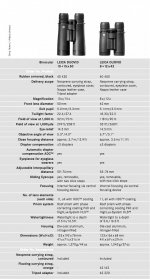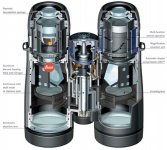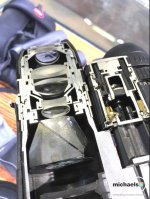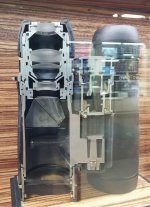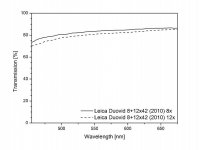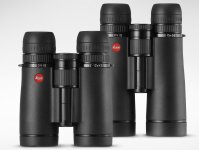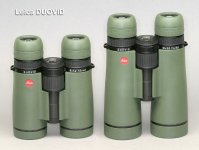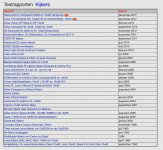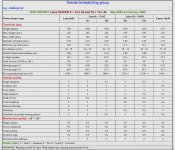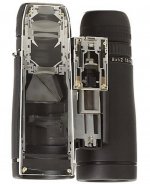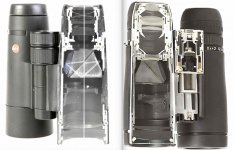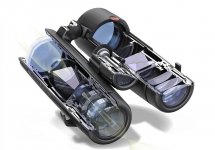John A Roberts
Well-known member

Unique among the premium brands, Leica offers a binocular with a limited ‘zoom’ capability - the Duovid
More correctly it’s a dual magnification system, with the higher magnification providing a 50% increase in power
The Duovid was introduced in 2002 and comes in 2 models: 8+12x42 and 10+15x50
See both the attached specifications (indicating that each model has 11 lenses per side), and a drawn cutaway view of the x42 version which gives some idea of the internal construction
I recently came across 2 images taken from different angles, of an actual cutaway Duovid x42, that make the optical construction much clearer - and prompted this thread
The first image is from: https://michaels.com.au/blogs/camera-review/leica-noctivid-binoculars-simply-amazing
And the second from: https://imgur.com/gallery/3XA9G3M
As can be seen, the construction comprises:
- 4 objective lenses in 3 groups (2, 1 + 1 focusing lens), and
- 7 ocular lenses in 4 groups (2, 1, 2, 2)
The first 3 groups in the eyepiece move in unison when the power is changed, with the rear stationary group sealing the end of the unit
** EDIT: after having had another look at the two images of the cutaway unit, and then comparing them to the drawn cutaway,
it seems that the first eyepiece group is stationary, and that only the middle 2 groups move
i.e. the middle 2 groups seem to be in a cylinder, that can slide inside a larger housing, that has the front and rear groups at the two ends **
The convenience of the Duovid's dual power - combined with high optical quality - comes with several limitations compared to comparable conventional binoculars:
- extra weight, smaller field of view and limited eye relief (measured on the x50 as 12 to 13 mm from the eye lens surface - see Roger Vine below)
- and of course cost
And as the Duovid is essentially a low production speciality item, many of the updates that have been made over the years to other Leica binoculars, have not been applied to the Duovid
While there’s not a lot of information available about the Duovids:
A) Roger Vine has provided a detailed review of the 10+15x50 (and comments on the 8-12x42) here: http://www.scopeviews.co.uk/LeicaDuovid.htm , and
B) Gijs van Ginkle has published transmission data about a 2010 production x42 unit
It’s from slide 32 of Gijs’ 2017 presentation on Multifunction Binoculars and Telescopes (comprising 111 slides and 19 MB) at: https://www.houseofoutdoor.com/verrekijkers/verrekijkers-testen-en-vergelijken/
John
More correctly it’s a dual magnification system, with the higher magnification providing a 50% increase in power
The Duovid was introduced in 2002 and comes in 2 models: 8+12x42 and 10+15x50
See both the attached specifications (indicating that each model has 11 lenses per side), and a drawn cutaway view of the x42 version which gives some idea of the internal construction
I recently came across 2 images taken from different angles, of an actual cutaway Duovid x42, that make the optical construction much clearer - and prompted this thread
The first image is from: https://michaels.com.au/blogs/camera-review/leica-noctivid-binoculars-simply-amazing
And the second from: https://imgur.com/gallery/3XA9G3M
As can be seen, the construction comprises:
- 4 objective lenses in 3 groups (2, 1 + 1 focusing lens), and
- 7 ocular lenses in 4 groups (2, 1, 2, 2)
The first 3 groups in the eyepiece move in unison when the power is changed, with the rear stationary group sealing the end of the unit
** EDIT: after having had another look at the two images of the cutaway unit, and then comparing them to the drawn cutaway,
it seems that the first eyepiece group is stationary, and that only the middle 2 groups move
i.e. the middle 2 groups seem to be in a cylinder, that can slide inside a larger housing, that has the front and rear groups at the two ends **
The convenience of the Duovid's dual power - combined with high optical quality - comes with several limitations compared to comparable conventional binoculars:
- extra weight, smaller field of view and limited eye relief (measured on the x50 as 12 to 13 mm from the eye lens surface - see Roger Vine below)
- and of course cost
And as the Duovid is essentially a low production speciality item, many of the updates that have been made over the years to other Leica binoculars, have not been applied to the Duovid
While there’s not a lot of information available about the Duovids:
A) Roger Vine has provided a detailed review of the 10+15x50 (and comments on the 8-12x42) here: http://www.scopeviews.co.uk/LeicaDuovid.htm , and
B) Gijs van Ginkle has published transmission data about a 2010 production x42 unit
It’s from slide 32 of Gijs’ 2017 presentation on Multifunction Binoculars and Telescopes (comprising 111 slides and 19 MB) at: https://www.houseofoutdoor.com/verrekijkers/verrekijkers-testen-en-vergelijken/
John
Attachments
Last edited:




